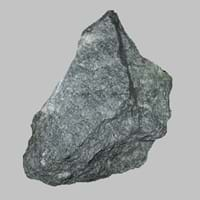Definition
It is a metamorphic magnesium rich rock because it is composed of the mineral talc
Andesite is a dark, fine-grained, brown or greyish intermediate volcanic rock which is a commonly found in lava
Discoverer
Unknown
Unknown
Etymology
From 17th century, because of its greasy feel and use like a soap
From Andes mountains, where it is found in abundance
Class
Metamorphic Rocks
Igneous Rocks
Sub-Class
Durable Rock, Soft Rock
Durable Rock, Hard Rock
Group
Not Applicable
Volcanic
Other Categories
Fine Grained Rock, Opaque Rock
Fine Grained Rock, Opaque Rock
Texture
Polished
Aphanitic to Porphyritic
Color
Black, Black to Grey, Green, Grey
Bluish - Grey, Grey, Pink, Yellow
Durability
Durable
Durable
Appearance
Dull, Banded and Foilated
Dull and Soft
Interior Uses
Bathrooms, Decorative Aggregates, Homes, Interior Decoration
Decorative Aggregates, Floor Tiles, Homes, Interior Decoration, Kitchens
Exterior Uses
As Facing Stone, Garden Decoration
Office Buildings, Roof Tiles
Other Architectural Uses
Curbing
Curbing
Construction Industry
Manufacture of Magnesium and Dolomite Refractories
Cobblestones, Construction Aggregate, for Road Aggregate
Medical Industry
Taken as a Supplement for Calcium or Magnesium
Not Yet Used
Antiquity Uses
Artifacts, Jewellery, Monuments, Sculpture
Artifacts, Monuments, Sculpture, Small Figurines
Commercial Uses
Cemetery Markers, Creating Artwork, Gemstone, Jewelry, Manufacture of Soap, Solvents, Dyes, Plastics and Fibres, Production of Lime, Source of Magnesia (MgO)
Commemorative Tablets, Creating Artwork
Types
Not Available
Icelandite
Features
Host Rock for Lead
Generally rough to touch, High silica content, Is one of the oldest rock
Archaeological Significance
Famous Monuments
Christ the Redeemer in Rio de Janeiro, Stonehenge in English county of Wiltshire
Middle of the Earth in Ecuador
Famous Sculptures
Data Not Available
Data Not Available
Pictographs
Used
Not Used
Petroglyphs
Used
Not Used
Formation
Soapstone is a talc-schist, which is a type of metamorphic rock and it is largely composed of the mineral talc and is thus rich inmagnesium.
Andesite is a fine-grained igneous rock that forms when the magma is erupted onto the surface and is crystallized quickly.
Mineral Content
Albite, Apatite, Biotite, Calcite, Carbonate, Clay Minerals, Hornblende, Ilmenite, Micas, Plagioclase, Pyroxene, Quartz
Amphibole, Apatite, Biotite, Feldspar, Garnet, Hornblade, Ilmenite, Magnetite, Plagioclase, Pyroxene, Zircon
Compound Content
CaO, Mg, MgO
Silicon Dioxide
Types of Metamorphism
Burial Metamorphism, Cataclastic Metamorphism, Contact Metamorphism, Hydrothermal Metamorphism, Impact Metamorphism, Regional Metamorphism
Burial Metamorphism, Cataclastic Metamorphism, Contact Metamorphism, Hydrothermal Metamorphism, Impact Metamorphism, Regional Metamorphism
Types of Weathering
Not Applicable
Biological Weathering, Chemical Weathering, Mechanical Weathering
Types of Erosion
Not Applicable
Chemical Erosion, Coastal Erosion, Glacier Erosion
Grain Size
Fine Grained
Very fine-grained
Fracture
Conchoidal
Uneven
Porosity
Less Porous
Less Porous
Cleavage
Perfect
Not Available
Specific Gravity
2.86
2.5-2.8
Transparency
Opaque
Opaque
Density
2.8-2.9 g/cm3
2.11-2.36 g/cm3
Resistance
Heat Resistant, Pressure Resistant
Heat Resistant, Pressure Resistant, Wear Resistant
Deposits in Eastern Continents
Asia
China, India, Indonesia, Japan, North Korea, Russia, Saudi Arabia, Singapore, South Korea, Sri Lanka, Tajikistan, Thailand
India, Indonesia, Japan, Nepal, South Korea
Africa
Egypt, Ethiopia, Ghana, South Africa, Western Africa
Egypt, Ethiopia, Morocco, Namibia, South Africa, Tanzania
Europe
Austria, England, Finland, France, Germany, Greece, Spain, Sweden, Switzerland, United Kingdom
Austria, Finland, Germany, Italy, Romania, Turkey, United Kingdom
Others
Not Yet Found
Not Yet Found
Deposits in Western Continents
North America
Canada, USA
Mexico, USA
South America
Colombia
Argentina, Bolivia, Chile, Colombia, Ecuador, Peru, Venezuela
Deposits in Oceania Continent
Australia
Central Australia, New Zealand, Queensland
New South Wales, New Zealand, Western Australia
Soapstone vs Andesite Characteristics
Though some rocks look identical, they have certain characteristics which distinguish them from others. Characteristics of rocks include texture, appearance, color, fracture, streak, hardness etc. Soapstone vs Andesite characteristics assist us to distinguish and recognize rocks. Also you can check about Properties of Soapstone and Properties of Andesite. Learn more about Soapstone vs Andesite in the next section. The interior uses of Soapstone include Bathrooms, Decorative aggregates, Homes and Interior decoration whereas the interior uses of Andesite include Decorative aggregates, Floor tiles, Homes, Interior decoration and Kitchens. Due to some exceptional properties of Soapstone and Andesite, they have various applications in construction industry. The uses of Soapstone in construction industry include Manufacture of magnesium and dolomite refractories and that of Andesite include Cobblestones, Construction aggregate, For road aggregate.
More about Soapstone and Andesite
Here you can know more about Soapstone and Andesite. The life cycle of a rock consists of formation of rock, composition of rock and transformation of rock. The composition of Soapstone and Andesite consists of mineral content and compound content. The mineral content of Soapstone includes Albite, Apatite, Biotite, Calcite, Carbonate, Clay Minerals, Hornblende, Ilmenite, Micas, Plagioclase, Pyroxene, Quartz and mineral content of Andesite includes Amphibole, Apatite, Biotite, Feldspar, Garnet, Hornblade, Ilmenite, Magnetite, Plagioclase, Pyroxene, Zircon. You can also check out the list of all Metamorphic Rocks. When we have to compare Soapstone vs Andesite, the texture, color and appearance plays an important role in determining the type of rock. Soapstone is available in black, black to grey, green, grey colors whereas, Andesite is available in bluish - grey, grey, pink, yellow colors. Appearance of Soapstone is Dull, Banded and Foilated and that of Andesite is Dull and Soft. Properties of rock is another aspect for Soapstone vs Andesite. The hardness of Soapstone is 1 and that of Andesite is 7. The types of Soapstone are Not Available whereas types of Andesite are Icelandite. Streak of rock is the color of powder produced when it is dragged across an unweathered surface. The streak of Soapstone is black while that of Andesite is white. The specific heat capacity of Soapstone is 0.88 kJ/Kg K and that of Andesite is 2.39 kJ/Kg K. Depending on the properties like hardness, toughness, specific heat capacity, porosity etc., rocks are resistant to heat, wear, impact, etc.Soapstone is heat resistant, pressure resistant whereas Andesite is heat resistant, pressure resistant, wear resistant.





